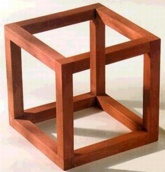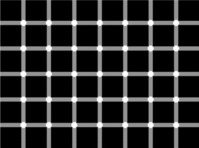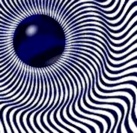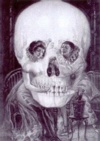
There are several classic optical illusions. One is an alternating figure variously called a magic cube or a Necker cube (Louis Necker, a Swiss crystallographer, first published his analysis of this design in 1832): the wireframe cube in the center below. Which of its sides is nearest to you? Is it the one made solidly green on the cube to the left or is it the green side on the cube to the right, or is there no nearest side at all?

More people interpret a magic cube as the one on the left than the one on the right. The most likely reason seems to be that people see boxes more often from above than from below.
Here is an "impossible" version pictured with a high degree of realism. The two points where the linear edges must overlap have been purposely confused. The resulting figure produces an even more jarring figure-ground dilemma, likely to be interpretted as humorous or upsetting.

Here's another classic, known as the Muller-Lyer illusion. Which of the horizontal lines is longer?

Measure them. You may be surprised to learn that they are the same length. Our tendency to misjudge the length of such lines (as with our tendency to be confused by magic cubes) stems from experiences which have "taught" us to use certain shapes and angles to tell us about size and placement. Such experiences established the conventions of linear perspective.

How many black dots can you count?
The illusory black dots you see are afterimages. This gridded figure is known as a "Hermann grid," named after its designer. L. Hermann visualized it in 1870, while reading a book about sound.![]()

Here is a very active radial design that relies upon afterimages. See the whole thing.
Other optical illusions rely upon our experience of stereoscopic vision -- 3-D movies for instance.
More examples:
Germany, Young Woman / Old Woman, 1888, postcard. This is the earliest known form of an image that has been reworked many times since. Deriving meaning from this ambiguous or alternating figure depends on which picture elements the eye perceives most strongly -- one at a time -- not simultaneously.

Ill-Fated Lovers, c. 1890-1920. Here is
another ambiguous or alternating figure.
Marcel Duchamp (French-American, 1887-1968), Rotorelief (Optical Discs), 1935-1953, two editions, two circular discs magnetized 1 inch and 2 inch dark borders, drawings on 6 discs, both sides 7 7/8 inch diameter, casing 14 3/4 x 14 3/4 inches. When viewed (preferably with one eye) at a rotating speed of 40-60 rpm, the disks present an optical illusion of depth, and in a few cases, of three-dimensional objects: a fishbowl a light bulb, and a balloon. Also see Dada.

Maurits Cornelis Escher (Dutch, 1898-1972),
Balcony, 1945, lithograph,
11 3/4 x 9 1/4 inches (29.7 x 23.4 cm), National Gallery of Art,
Washington, DC. In the center of this picture of a hillside town,
Escher said he tried to break up the paper's flatness by "pretend[ing]
to give it a blow with my fist at the back, but . . . the paper
remains flat, and I have only created the illusion of an illusion."

Maurits Cornelis Escher, Other World, 1947, color wood
engraving and woodcut
printed in black, red-brown, and green, printed from three blocks; image 12 1/2 x 10
1/4 inches (31.8 x 26.1 cm), sheet 39.2 x 32.9 cm; Fine Arts
Museums of San Francisco, CA. Depending upon which of this room's
three windows we look out, we find our point
of view is completely different and irreconsilable from each
of the others.
Maurits Cornelis Escher, Up and Down, 1947, lithograph, 19 3/4 x 8 1/8 inches (50.3 x 20.5 cm).

Maurits Cornelis Escher, Drawing Hands, 1948, lithograph,
11 1/8 x 13 1/8 inches (282 x 332 mm).

Maurits Cornelis Escher, Relativity, 1953, lithograph,
11 1/8 x 11 5/8 inches (282 x 294 mm), National Gallery of Art,
Washington D.C. Here three worlds, each with their own gravitational
forces exist simultaneously, operating perpendicularly to one
other.

Maurits Cornelis Escher, Convex and Concave, 1955, lithograph. See convex
and concave.

Maurits Cornelis Escher, Print Gallery, 1956, lithograph,
image 31.9 x 31.7 cm, sheet 41.2 x 40.4 cm, Fine Arts Museums
of San Francisco, CA. See gallery.

Maurits Cornelis Escher, Belvedere, 1958, lithograph,
8 1/4 x 11 5/8 inches (462 x 295 mm), National Gallery of Art,
Washington, DC. This belvedere has three stories, but its drawing
results in an optical illusion. Escher has employed a hybrid
of linear perspective
that produces a mixture of two possibilities. Note how the pillars connect the second
to the third story.

Maurits Cornelis Escher, Waterfall, 1961, lithograph,15
x 11 3/4 inches (380 x 300 mm).
Three designs that rely on afterimages to produce illusions of movement:
Also see afterimage, alternating figure, ambiguity, anamorphosis, closure, moiré, mathematics and art, Op Art, reversible, tessellation, and trompe l'oeil.
https://inform.quest/_art